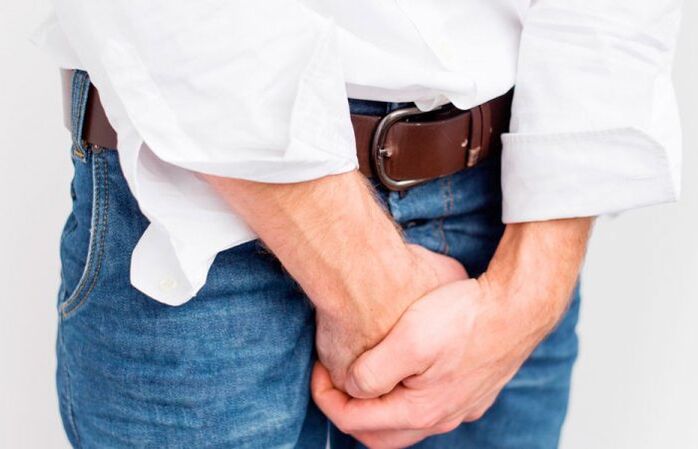Symptoms of prostatitis can be detected a few days after the onset of the disease. Depending on the age, individual condition of the patient and other nuances, the disease may manifest itself or proceed more quietly. Early referral to a doctor and timely diagnosis guarantee successful treatment, the absence of complications and relapses.

Risk group
Inflammation of the prostate gland in men is diagnosed more and more often. The essence of the disease is simple. The gland, which is normally very small, enlarges dramatically, compressing the urethra and seminal ducts, causing problems with urination and normal ejaculation. There are many reasons for the occurrence of the disease. The following patients are at risk:
- middle and older age;
- overweight and obesity;
- smokers and alcohol abusers;
- those with diseases of the genitourinary organs (urethritis, cystitis, orchitis, balanitis, balanoposthitis, pyelonephritis);
- irregular sex life;
- use coitus interruptus as the main means of contraception;
- treated with strong drugs (hormonal agents, antibiotics).

A few decades ago, symptoms of the disease were observed in middle-aged and elderly patients. But today, the disease is more and more common in young active men who do not have any particular health problems. Urologists distinguish 4 types of prostatitis: acute and chronic infectious, non-bacterial, prostatodynia.
The acute infectious form is more common in young, sexually active men. The cause of the disease is bacteria that have entered the urethra and urethra. The source of infection is often the causative agent of sexually transmitted diseases: streptococci, gonococci, pale spirochetes, trichomonas, chlamydia. In some cases, bacteria enter the urethra from the rectum. This happens with insufficient hygiene of the genitals. In the absence of adequate treatment, acute infectious prostatitis can become chronic. It is characterized by periods of rest alternating with sudden deterioration of well-being. As the disease progresses, attacks become more frequent and last longer.
The onset of the disease: how to determine it
The first symptoms of prostatitis are easily confused with the manifestations of other diseases. Therefore, patients do not rush to the doctor by taking painkillers or antipyretic drugs on their own. One sign that should alert you is going to the toilet a lot. A man begins to notice that a small amount of urine is released, becomes dark or almost transparent. Gradually, the process of urination becomes painful, itching and burning are felt in the urethra, the external genital organs become irritated and reddened.

Another characteristic manifestation is a constant feeling of fullness in the bladder. An enlarged gland compresses the urethra, urine drips or leaks spontaneously. There may be nocturnal incontinence and discharge of pus, discharge, or mucus from the urinary tract.
Sexual dysfunction is observed almost at the same time. Enlarged prostate blocks the flow of testosterone, men note a decrease in libido, premature ejaculation, and deterioration of erection.
Against the background of the inflammatory process and failures in the genital area, the patient becomes irritable, irritable, flare-ups of aggression or depression, depressed mood are possible.
Fatigue is very common. An active person gets tired quickly, feels sleepy, but even a long sleep does not bring joy. Decreased efficiency, the body cannot resist infections. As a result, even a common cold ends with complications that worsen the patient's condition.
Signs and symptoms

Symptoms of prostatitis in men can be overt or hidden. All this depends on the individual characteristics of the body, the presence or absence of other chronic diseases, age and other important factors. Usually, the first characteristic manifestations occur a few days or weeks after the onset of the disease. These include:
- repeated false urge to urinate;
- pain in the urethra during and after urination;
- local edema in the genital area;
- feeling that the bladder is not completely empty;
- problems with urination;
- dull aching pain in the lower abdomen;
- discomfort in the scrotum and lower back;
- general disorder;
- short-term increase in temperature.
A patient with prostatitis may have problems with sleep and appetite, often replaced by constipation and diarrhea. The main symptoms of prostatitis, characteristic of the non-bacterial form, appear and disappear, become more obvious or significantly weaken. With chronic inflammation of the prostate, characteristic symptoms do not make themselves felt for a long time.
They can be so lethargic that the man does not show concern, he associates his health deterioration with cold, stress, fatigue at work. According to statistics, almost a quarter of patients do not feel discomfort for several months after the onset of the disease.

Acute infectious prostatitis, the symptoms of which become noticeable after a few days, manifests itself as a sharp increase in temperature, burning and pain in the urethra, and a constant desire to visit the toilet. The patient feels chills and fever. Possible stool problems. In the inflammatory process, the tissues are loosened and easily damaged. The patient postpones going to the toilet, the stool is tight and difficult to pass through the rectum. In severe form, the development of hemorrhoids, the appearance of cracks in the rectum, and other unpleasant consequences are possible.
A striking symptom of acute prostatitis is the appearance of traces of blood and pus in the urine. Urine becomes cloudy and has an unpleasant smell. Urine comes out drop by drop or stays for several hours causing severe bloating. Everything speaks of an acute inflammatory process. At the first signs of prostatitis, it is recommended to contact a therapist who will give a referral to a urologist.
Prostatodynia and its symptoms
Prostatodynia is a non-inflammatory form of prostatitis. It occurs in 30% of middle-aged and elderly men. The disease continues in latent or acute form, accompanied by a number of symptoms characteristic of non-infectious prostatitis.
The main difference of this form of the disease is the absence of high temperature, edema, pus. At the same time, the patient constantly feels pain of a very different nature: pulling, aching, throbbing. It can be localized in the lower back, legs, lower abdomen, scrotum or perineum extending to the penis. Pain occurs at rest or during overexertion; Blockades of painkillers or the use of strong drugs can relieve the attack. Antibiotics do not help, because there is no inflammatory component.
Prostatodynia is characterized by problems with urination. Among them:
- slow flow;
- drip leak;
- incomplete emptying of the bladder;
- frequent false calls;
- dysuria (absence of urine).
How to make a diagnosis

With prostatitis of any nature, the main thing is not to delay treatment for a long time. Only a urologist can understand what forms the disease will take and what to choose for a quick recovery. The peculiarity of inflammation of the prostate gland is that the disease is easily confused with other diseases.
For example, urinary problems are characteristic of chronic or acute urethritis or cystitis. Pain in the lower abdomen and the appearance of blood in the urine can indicate pyelonephritis.
Finally, the deterioration of general well-being is characteristic of the whole list of diseases, from the banal flu to rectal cancer.
A series of tests and ultrasound examination to assess the condition of the prostate will help to avoid mistakes and improper treatment.
If the cause of the disease is an infection of the urinary tract, it is necessary to get rid of it, and only after that it is necessary to continue to eliminate the symptoms of prostatitis.
A few decades ago, it was believed that the disease was characteristic of older men, but today, quite a few young people who lead an active lifestyle also suffer from this disease. After finding the characteristic symptoms, you should immediately consult a doctor who will make a diagnosis and choose the right treatment.























